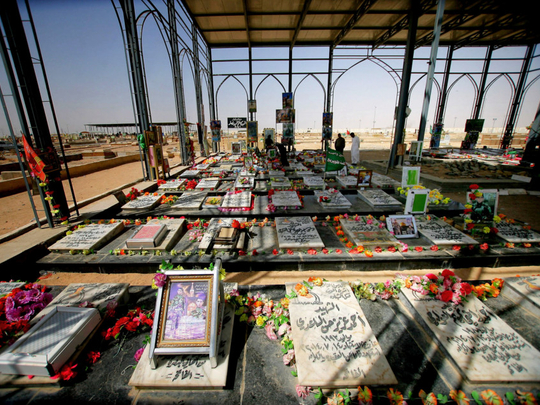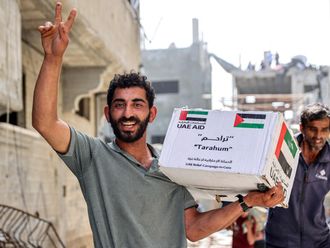
Najaf: Every chapter of Iraq’s modern history can be seen in this great, sprawling city of the dead, its mausoleums stretching across the horizon from one of the holiest Shiite shrines. And now, its sandy expanse grows again yet with the war dead killed by the country’s latest adversary, the extremists of the Daesh group.
“I expect that these graveyards will be expanded as more fighting against Daesh looms in the horizon,” said Ali Abdul Ahli, the city official in charge of Najaf cemetery.
Kings, scientists, artists, warriors and millions of others have a final resting place at Wadi Al Salam, or the ‘Valley of Peace’ in Arabic, buried one atop the other in one of the world’s largest cemeteries. The roughly 10-square-kilometre graveyard radiates out from the tomb of Imam Ali, the cousin and son-in-law of the Prophet Mohammad (PBUH).
In its narrow rows, a visitor can find those killed in Iraq’s long war in the 1980s with Iran or those slain in the sectarian bloodletting that followed the US-led invasion of the country in 2003. Gravediggers shrug off questions about how many people have been buried here since the cemetery’s founding a 1,000 years ago, simply saying millions.
But in recent months, the growth of areas set aside for government-allied militias fighting Daesh has been easy to see. Tens of thousands of men answered a nationwide call-to-arms by a top Shiite cleric, Grand Ayatollah Ali Al Sistani, after the extremists seized a third of Iraq last year. The militias, backed by Iranian advisers, have played a key role in halting the extremists’ advance and helped Iraq recently retake the city of Tikrit, Saddam Hussain’s hometown.
In one section given to a militia, Ahmad Hamid washed the grave of his cousin killed three months ago while fighting against the militants near the city of Samarra, home to another shrine.
“Our family is very proud of my fallen cousin who sacrificed his life in order to protect Shiite sacred shrines,” Hamid said.
Iraqi authorities have refused to offer any casualty figures for security forces or the militias battling the Daesh group. But on a recent trip to Najaf, an Associated Press reporter saw at least two buses carrying coffins wrapped with Iraqi flags.
Abdul Ahli, the Najaf city official, said authorities have offered six parcels of cemetery land to the militias, who must cover construction and maintenance costs, as a “gesture of gratitude to the Shiite fighters who joined the war against Daesh.”
In the cemetery, one new section is for the Iranian-backed Hezbollah brigades, which is separate from the Lebanese group of the same name. Three tombs belong to an uncle and his two nephews who took up arms on their own in June. They died three days later in a bomb blast in Jurf Al Sakhar, south of Baghdad.
Jabir Al Bugharban, a guard at that section of the graveyard, said that it was originally built for Iraqi fighters killed in Syria’s civil war, but later expanded to take in those killed in battle against the Daesh group in Iraq. During heavy fighting in Salahuddin and Al Anbar provinces, Al Bugharban said his graveyard receives about six bodies a day.
At a separate section for the militia Asaib Ahl Al Haq, or ‘the People of Righteousness,’ militiaman Ahmad Sabah Hassan washed the grave of his brother, Nouri, with rose water.
Hassan said his brother was killed along with five other fighters when a suicide car bomb hit their vehicle in mid-March near Tikrit, where both fought against Daesh.
A picture of Hassan’s brother, surrounded by artificial red and yellow flowers, stands on his tomb, along with his inscribed name and the date of his death. Miniature Iraqi flags waved around it in the wind.
Before saying goodbye to his dead brother, Hassan vowed to return to Tikrit to continue the fight. “The death of my brother has only made me more determined to fight Daesh,” he said. “We will never quit our struggle to defend our religion and sacred places until the terrorists are rooted out from Iraq.”











